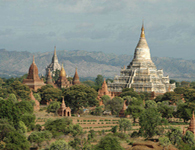Situated about 23km to the south of Battambang, Prasat Banan and exactly 358 stone steps leading up to Phnom Banan is a modest temple having familiar style like Angkor Wat in Siem Reap. Although being an optimistic claim, Phnom Banan is also claimed to be the inspiration for Angkor Wat. Travel Indochina Laos
The son of Suryavarman I, Udayadityavarman II was thought to have built Prasat Banan in the 11th century. Thanks to the ideal position, its hillside location offers spectacular panoramic views of the surrounding countryside. These impressive carved traverses above the doorways to each tower and sculpture on the top parts of the central tower are what make this temple so unique. Some of the best carvings of this temple are now displayed in the Battambang Museum. You can also visit a narrow stone staircase leading to the south down the hill to three caves from the temple with a local guide.
Taking a leisurely forty minute trip to Wat Banan you will have a chance to see the lotus plant shaped like the spires of the Wat rising above the trees around the phnom to the right of this temple. Just a few metres past the iron bridge on the left you can see the entrance crossing the Sangkar to the east side. It is also an alternative road back to Battambang, both on the winding beautiful river road and the main road set back a few hundred meters away. Laos travel tours
At the bottom of the phnom, right in the entrance courtyard area, there are about three or four restaurants and a tourist ticket booth where you have to pay $2 before the steps up and catch some refreshments before you climb. The sharp slope of more than three hundred stones to climb to the top takes no prisoners, and is affiliating. The word ‘hot’- meaning tired is exclaimed many times by the locals because of the fact that everyone climbing to the top seem to be taking a couple of rest breaks during the challenge.
Made up of four temple towers together with a further one in the centre, the original temple Wat Banan dates back to 1050 during the reign of king Udayadityavarman I as a Hindu temple. Later in around 1219, during the reign of king Jayarvarman VII, people used the same stones to rebuild this temple as a Buddhist temple. Laterite which is the most popular material used so much nowadays for bars and hotel receptions in Phnom Penh and Siem Reap is the main material coming with sandstone to build Banan. The towers are undoubtedly impressive and basically impaired with a light brown sediment rock and lots of small holes within it.
After squeezing through an easy to miss crevice in a modest rocky outcrop and after some of short squatted crawls the cave opens into two magical spacious chambers, with a trunk of light permeating from above. A large stalactite hanging from the ceiling with sacred brightly shining water dropping from it into a bowl below is what you can see when coming here.
Travel lovers.
Read more:
- Classic Adventure Vietnam and Laos (16 Days, 15 Nights)
- Lao Mekong cruise with The World Heritage sites (14 Days, 13 Nights)
- Luang Prabang 4 days 3 nights 2 with Elephant Village












